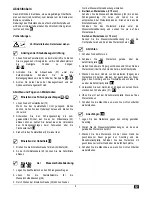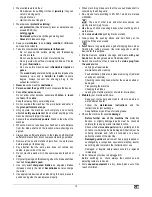
15
Electrical safety
Extension cable
to be designed in compliance with IEC 60
245 (H 07 RN-F) having a core cross-section of at least:
−
1.5 mm² for cable lengths
up to
25 m
−
2.5 mm² for cable lengths
over
25m
Long and thin connection lines result in a potential drop. The
motor does not reach any longer its maximal power; the
function of the device is reduced.
Plugs
and
coupler outlets
on connection cables must be
made of rubber, non-rigid PVC or other thermoplastic
material of same mechanical stability or be covered with this
material.
Protect yourself against an
electric shock
. Avoid touching
earthed parts with your body.
The connector of the connection cable must be
splash-
proof.
Wind off completely the cable when using a cable drum.
Do not use the
cable
for purposes for which it is not meant.
Protect
the cable against
heat, oil and sharp edges
. Do
not use the cable to pull the plug from the socket.
Regularly check the cable and if damaged, have it
renewed
by a recognised skilled electrician.
When running the
connection line
observe that it does not
interfere, is not squeezed, bended and the plug connection
does not get wet.
Regularly check the
extension cables
and replace them if
they are damaged.
Do not use
any defective connection cables.
Do not set up any provisional
electrical connections.
Never bypass
protective devices or deactivate them.
Only hook up the machine by means of a
fault-current
circuit breaker
(30 mA).
The
electrical connection or repairs
to electrical parts of
the machine must be carried out by a
certified
electrician
or one of our customer service points. Local regulations –
especially regarding protective measures – must be
observed.
Repairs
to other parts of the machine must be carried out
by the manufacturer or one of his customer service points.
Use only original spare parts and accessory parts.
Accidents can arise for the user through the
use of other
spare parts
. The manufacturer is not liable for any
damage or injury resulting from such action.
Before the first start-up
To achieve flawless functioning of the machine, please
follow the instructions listed:
Place the
surface planing and thicknessing machine
at a
location which meets following conditions:
−
secured against slipping
−
free of vibrations
−
even
−
free of tripping hazards
−
adequate light
Before each use
, check
−
Connection cables
for defects (cracks, cuts, etc.).
Do not use any defective cables.
−
whether the
pushstick
is to hand
−
Is the unused blade shaft covered by the blade shaft
guard?
When working do not stand directly in front or behind the
machine but stand to the side.
You have to attach the following parts:
Base frame
A1
-
A7
Assemble the four parts of the stand as shown in the figures
A1 through A7.
Use a second person to place the surface planing and
thicknessing machine on the stand.
Secure the surface planing and thicknessing machine to the
stand.
Securing on the floor
A8
Secure the surface planing and thicknessing machine to the
floor using 4 screws.
Guide plate
Secure the guide plate guideway (7) to the housing.
Slide in the guide plate holder (10) and secure the locking
lever (12).
Mount the guide plate (13).
Shavings exhauster
C1
-
C7
Install the shavings exhauster connector (16).
Connect the shavings exhauster hose (17) and secure it
using a hose band clip (18).
Connect the shavings exhauster hood (27) to the exhaust
hose and tighten the hose band clip.
Attach the shavings bag (19) to the exhauster connector and
secure it using the hose band clip.
Start-up
Mains connection
Compare the voltage listed on the machine’s type plate, e.g.
230 V, with the mains voltage and connect the machine to a
suited and properly earthed electrical socket.
Alternating current motor:
Use a shockproof plug, mains voltage 230 V with residual
current circuit breaker and 10 A inert fuses.
Use connection cable or extension cable respectively with a
cross section of at least 1.5 mm².
















































